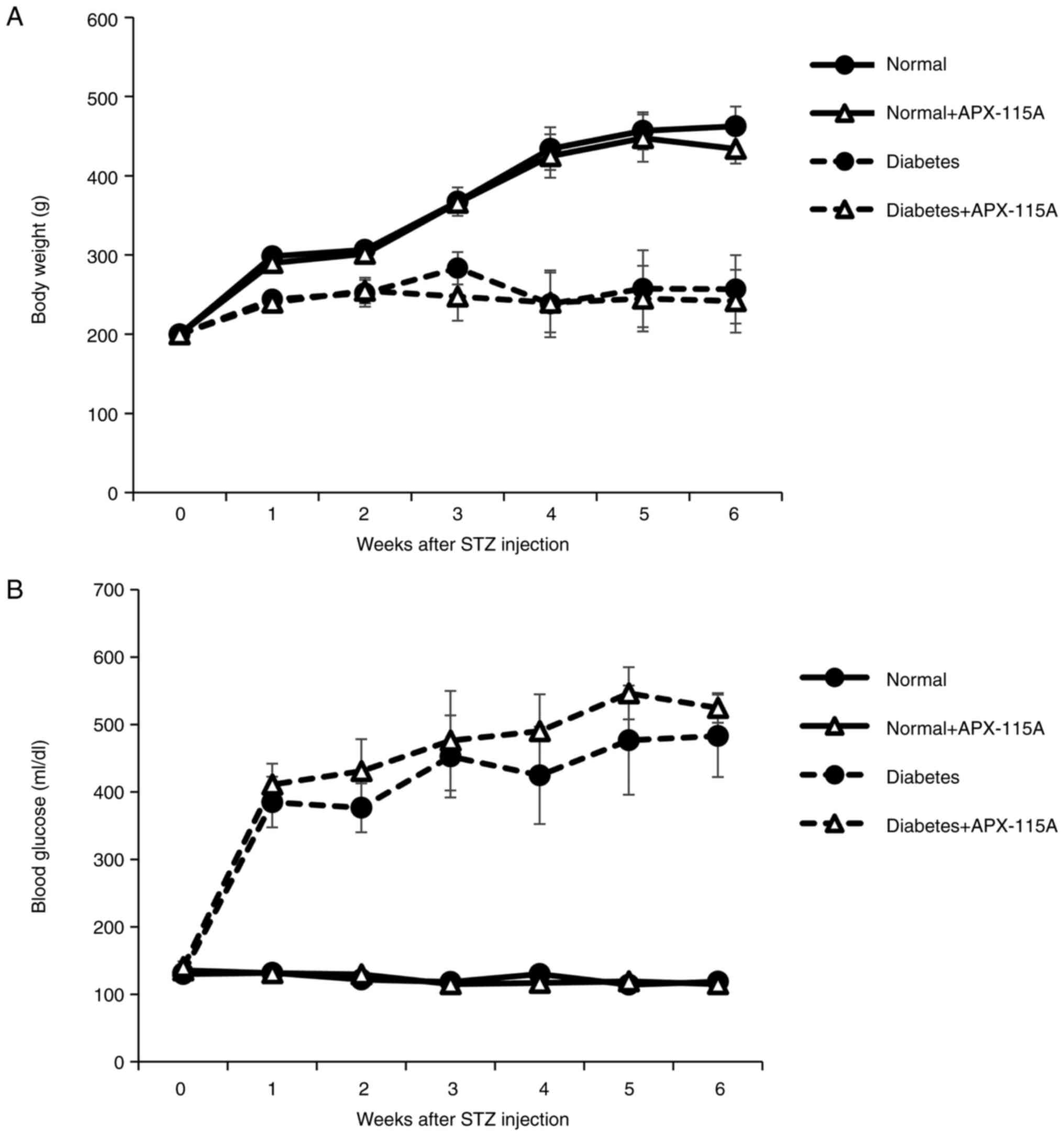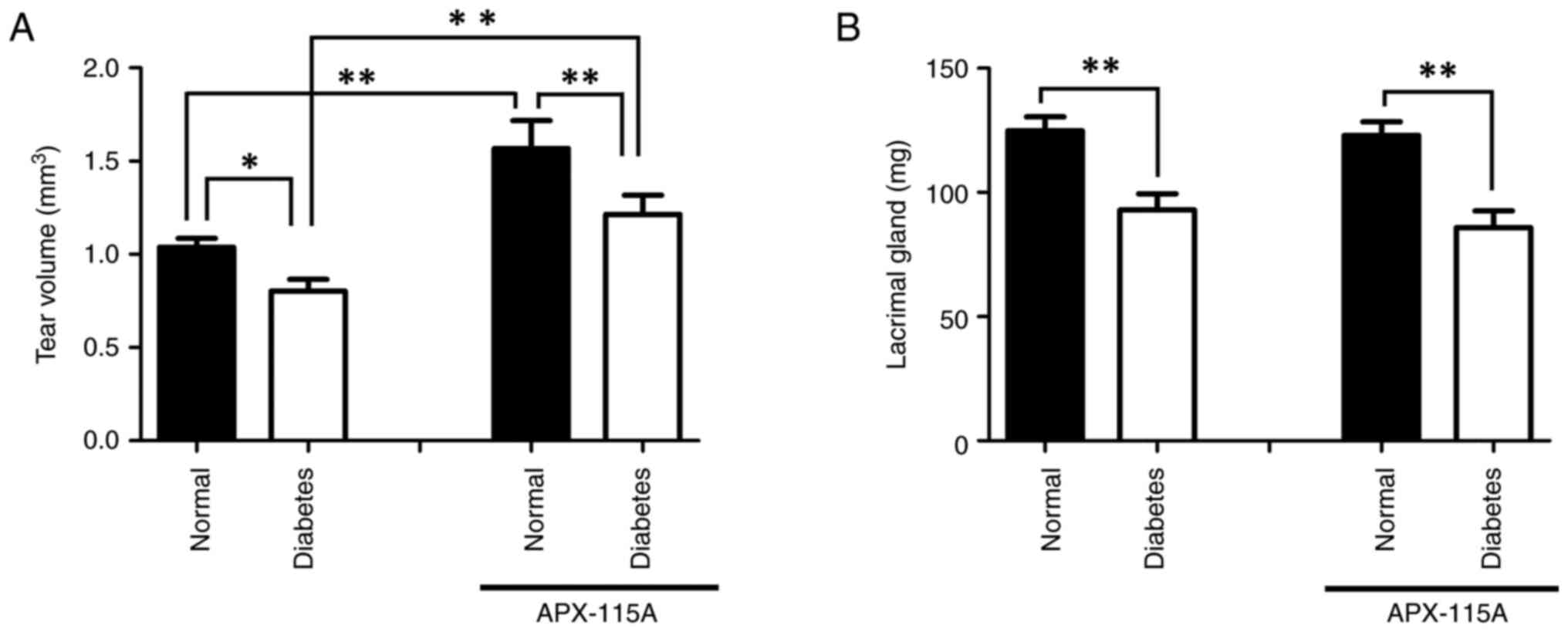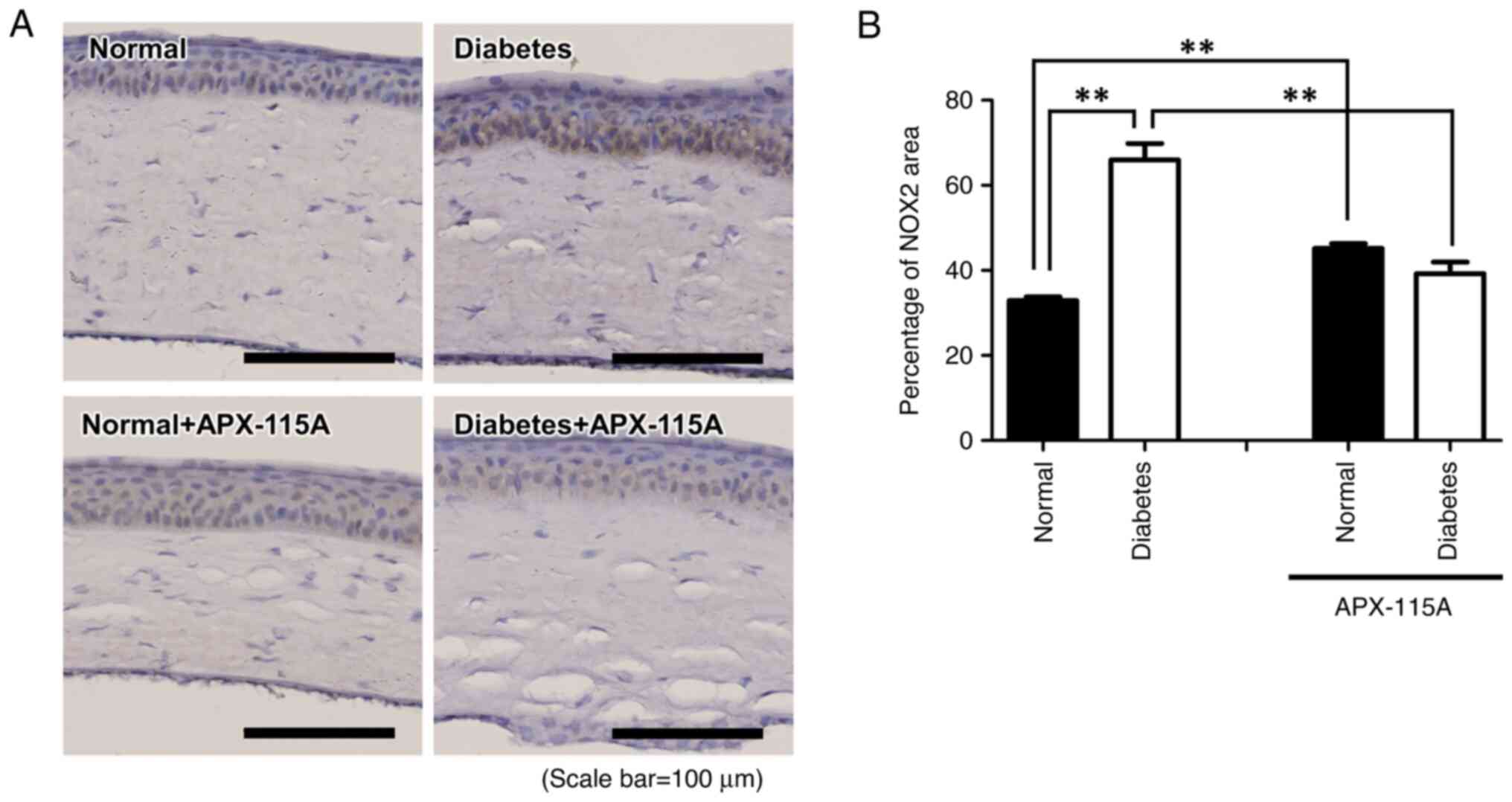|
1
|
Amos AF, McCarty DJ and Zimmet P: The
rising global burden of diabetes and its complications: Estimates
and projections to the year 2010. Diabet Med. 14 (Suppl 5):S1–S85.
1997.PubMed/NCBI
|
|
2
|
Ogurtsova K, Guariguata L, Barengo NC,
Ruiz PL, Sacre JW, Karuranga S, Sun H, Boyko EJ and Magliano DJ:
IDF diabetes Atlas: Global estimates of undiagnosed diabetes in
adults for 2021. Diabetes Res Clin Pract.
183(109118)2022.PubMed/NCBI View Article : Google Scholar
|
|
|
Lovic D, Piperidou A, Zografou I, Grassos
H, Pittaras A and Manolis A: The growing epidemic of diabetes
mellitus. Curr Vasc Pharmacol. 18:104–109. 2020.PubMed/NCBI View Article : Google Scholar
|
|
3
|
Chen C, Cohrs CM, Stertmann J, Bozsak R
and Speier S: Human beta cell mass and function in diabetes: Recent
advances in knowledge and technologies to understand disease
pathogenesis. Mol Metab. 6:943–957. 2017.PubMed/NCBI View Article : Google Scholar
|
|
4
|
Memon B and Abdelalim EM: Stem cell
therapy for diabetes: Beta cells versus pancreatic progenitors.
Cells. 9(283)2020.PubMed/NCBI View Article : Google Scholar
|
|
5
|
Cnop M, Welsh N, Jonas JC, Jörns A, Lensen
S and Eizirik DL: Mechanisms of pancreatic beta-cell death in type
1 and type 2 diabetes: Many differences, few similarities.
Diabetes. 54 (Suppl 2):S97–S107. 2005.PubMed/NCBI View Article : Google Scholar
|
|
6
|
Jean-Baptiste VSE, Xia CQ, Clare-Salzler
MJ and Horwitz MS: Type 1 diabetes and type 1 interferonopathies:
Localization of a type 1 common thread of virus infection in the
pancreas. EBioMedicine. 22:10–17. 2017.PubMed/NCBI View Article : Google Scholar
|
|
7
|
Tomita T: Apoptosis of pancreatic β-cells
in Type 1 diabetes. Bosn J Basic Med Sci. 17:183–193.
2017.PubMed/NCBI View Article : Google Scholar
|
|
8
|
Al-Mrabech A: β-Cell dysfunction, hepatic
lipid metabolism, and cardiovascular health in type 2 diabetes: New
directions of research and novel therapeutic strategies.
Biomedicines. 9(226)2021.PubMed/NCBI View Article : Google Scholar
|
|
9
|
Wu H and Mahato RI: Mesenchymal stem
cell-based therapy for type 1 diabetes. Discov Med. 17:139–143.
2014.PubMed/NCBI
|
|
10
|
Hopkins M, Beaulieu K and Finlayson G:
Psychobiology of appetite and food reward in adults with type 1 and
type 2 diabetes: Is there a role for exercise? Can J Diabetes.
44:768–774. 2020.PubMed/NCBI View Article : Google Scholar
|
|
11
|
Zand H, Morshedzadeh N and Naghashian F:
Signaling pathways linking inflammation to insulin resistance.
Diabetes Metab Syndr. 11 (Suppl 1):S307–S309. 2017.PubMed/NCBI View Article : Google Scholar
|
|
12
|
Xu H, Du X, Xu J, Zhang Y, Tian Y, Liu G,
Wang X, Ma M, Du W, Liu Y, et al: Pancreatic β cell microRNA-26a
alleviates type 2 diabetes by improving peripheral insulin
sensitivity and preserving β cell function. PLoS Biol.
18(e3000603)2020.PubMed/NCBI View Article : Google Scholar
|
|
13
|
Rossino MG and Casini G: Nutraceuticals
for the treatment of diabetic retinopathy. Nutrients.
11(771)2019.PubMed/NCBI View Article : Google Scholar
|
|
14
|
Chaurasia SS, Lim RR, Parikh BH, Wey YS,
Tun BB, Wong TY, Luu CD, Agrawal R, Ghosh A, Mortellaro A, et al:
The NLRP3 inflammasome may contribute to pathologic
neovascularization in the advanced stages of diabetic retinopathy.
Sci Rep. 8(2847)2018.PubMed/NCBI View Article : Google Scholar
|
|
15
|
Shih KC, Lam KSL and Tong L: A systematic
review on the impact of diabetes mellitus on the ocular surface.
Nutr Diabetes. 7(e251)2017.PubMed/NCBI View Article : Google Scholar
|
|
16
|
Kang JH and Shin SY: What is the meaning
of hs-CRP and HbA1c in patients with dry eye syndrome in diabetes?
J Korea Soc Comput Inform. 25:158–190. 2020.
|
|
17
|
Nadeem H, Malik TG, Mazhar A and Ali A:
Association of dry eye disease with diabetic retinopathy. J Coll
Physicians Surg Pak. 30:493–497. 2020.PubMed/NCBI View Article : Google Scholar
|
|
18
|
Almohammed BA, Alnafeesah AA, Aldharman
SS, Alensi MH, Mahjari AA, Albalawi FA, Amer KA, Alkhathami GH and
Al Taisan AA: Prevalence and severity of dry eye disease symptoms
among diabetics: A nationwide survey. Cureus.
14(e30981)2022.PubMed/NCBI View Article : Google Scholar
|
|
19
|
Zagon IS, Sassani JW and McLaughlin PJ:
Sex differences in diabetic ocular surface complications and
dysregulation of the OGF-OGFr pathway. J Diabetes Clin Res.
4:20–24. 2022.PubMed/NCBI View Article : Google Scholar
|
|
20
|
Gomes JAP and Santo RM: The impact of dry
eye disease treatment on patient satisfaction and quality of life:
A review. Ocul Surf. 17:9–19. 2019.PubMed/NCBI View Article : Google Scholar
|
|
21
|
Johnson ME and Murphy PJ: Changes in the
tear film and ocular surface from dry eye syndrome. Prog Retin Eye
Res. 23:449–474. 2004.PubMed/NCBI View Article : Google Scholar
|
|
22
|
Chiva A: Electrophoresis of tear proteins
as a new diagnostic tool for two high risk groups for dry eye:
Computer users and contact lens wearers. J Med Life. 4:228–233.
2011.PubMed/NCBI
|
|
23
|
Kaplan HJ: Anatomy and function of the
eye. Chem Immunol Allergy. 92:4–10. 2007.PubMed/NCBI View Article : Google Scholar
|
|
24
|
Dartt DA: Neural regulation of lacrimal
gland secretory processes: Relevance in dry eye diseases. Prog
Retin Eye Res. 28:155–177. 2009.PubMed/NCBI View Article : Google Scholar
|
|
25
|
Chu EPF, Cho CHH, Lee WJ, Lee IT, Cheng
IF, Kuo TC, Chen RY, Sheu WHH and Shen CH: Generation of three
induced pluripotent stem cell lines from type 2 diabetic patients
with ocular complications. Stem Cell Res. 49(102109)2020.PubMed/NCBI View Article : Google Scholar
|
|
26
|
Rüfer F and Erb C: Influence of dry eye
syndrome on glaucoma diagnostic procedures. Ophthalmologe.
109:1082–1086. 2012.PubMed/NCBI View Article : Google Scholar : (In German).
|
|
27
|
Stern ME, Beuerman RW, Fox RI, Gao J,
Mircheff AK and Pflugfelder SC: The pathology of dry eye: The
interaction between the ocular surface and lacrimal glands. Cornea.
17:584–589. 1998.PubMed/NCBI View Article : Google Scholar
|
|
28
|
Goto E, Shimazaki J, Monden Y, Takano Y,
Yagi Y, Shimmura S and Tsubota K: Low-concentration homogenized
castor oil eye drops for noninflamed obstructive meibomian gland
dysfunction. Ophthalmology. 109:2030–2035. 2002.PubMed/NCBI View Article : Google Scholar
|
|
29
|
Ribeiro MVMR, Barbosa FT, Ribeiro LEF,
Sousa-Rodrigues CF and Ribeiro EAN: Effectiveness of using
preservative-free artificial tears versus preserved lubricants for
the treatment of dry eyes: A systematic review. Arq Bras Oftalmol.
82:436–445. 2019.PubMed/NCBI View Article : Google Scholar
|
|
30
|
Toda I: Dry eye after LASIK. Invest
Ophthalmol Vis Sci. 59:DES109–DES115. 2018.PubMed/NCBI View Article : Google Scholar
|
|
31
|
Jha JC, Banal C, Chow BS, Cooper ME and
Jandeleit-Dahm K: Diabetes and kidney disease: Role of oxidative
stress. Antioxid Redox Signal. 25:657–684. 2016.PubMed/NCBI View Article : Google Scholar
|
|
32
|
Lee YC, Bae CS and Ahn TH: Chlorogenic
acid attenuates pro-inflammatory response in the blood of
streptozotocin-induced diabetic rats. Lab Anim Re.
38(37)2022.PubMed/NCBI View Article : Google Scholar
|
|
33
|
Li S, Deng J, Sun D, Chen S, Yao X, Wang
N, Ahang J, Gu Q, Zhang S, Wang J, et al: FBXW7 alleviates
hyperglycemia-induced endothelial oxidative stress injury via ROS
and PARP inhibition. Redox Biol. 58(102530)2022.PubMed/NCBI View Article : Google Scholar
|
|
34
|
Bedard K and Krause KH: The NOX family of
ROS-generating NADPH oxidases: Physiology and pathophysiology.
Physiol Rev. 87:245–313. 2007.PubMed/NCBI View Article : Google Scholar
|
|
35
|
Rojas M, Zhang W, Xu Z, Lemtalsi T,
Chandler P, Toque HA, Caldwell RW and Caldwell RB: Requirement of
NOX2 expression in both retina and bone marrow for diabetes-induced
retinal vascular injury. PLoS One. 8(e84357)2013.PubMed/NCBI View Article : Google Scholar
|
|
36
|
Roy K, Wu Y, Meitzler JL, Juhasz A, Liu H,
Jiang G, Lu J, Antony S and Doroshow JH: NADPH oxidases and cancer.
Clin Sci (Lond). 128:863–875. 2015.PubMed/NCBI View Article : Google Scholar
|
|
37
|
Venditti P and Di Meo S: Thyroid
hormone-induced oxidative stress. Cell Mol Life Sci. 63:414–434.
2006.PubMed/NCBI View Article : Google Scholar
|
|
38
|
Davalli P, Mitic T, Caporali A, Lauriola A
and D'Arca D: ROS, cell senescence, and novel molecular mechanisms
in aging and age-related diseases. Oxid Med Cell Longev.
2016(3565127)2016.PubMed/NCBI View Article : Google Scholar
|
|
39
|
Seen S and Tong L: Dry eye disease and
oxidative stress. Acta Ophthalmol. 96:e412–e420. 2018.PubMed/NCBI View Article : Google Scholar
|
|
40
|
Dogru M, Kojima T, Simsek C and Tsubota K:
Potential role of oxidative stress in ocular surface inflammation
and dry eye disease. Invest Ophthalmol Vis Sci. 59:DES163–DES168.
2018.PubMed/NCBI View Article : Google Scholar
|
|
41
|
Fresta CG, Fidilio A, Lazzarino G, Musso
N, Grasso M, Merlo S, Amorini AM, Bucolo C, Tavazzi B, Lazzarino G,
et al: Modulation of pro-oxidant and pro-inflammatory activities of
M1 macrophages by the natural dipeptide carnosine. Int J Mol Sci.
21(776)2020.PubMed/NCBI View Article : Google Scholar
|
|
42
|
Lee JE, Kim SY, Lee HK, Chung TY, Kim JY,
Choi CY, Chung SH, Kim DH, Kim KW, Chung JK, et al: A randomized
multicenter evaluation of the efficacy of 0.15% hyaluronic acid
versus 0.05% cyclosporine A in dry eye syndrome. Sci Rep.
12(18737)2022.PubMed/NCBI View Article : Google Scholar
|
|
43
|
Lee SR, An EJ, Kim J and Bae YS: Function
of NADPH oxidases in diabetic nephropathy and development of nox
inhibitors. Bio Ther (Seoul). 28:25–33. 2020.PubMed/NCBI View Article : Google Scholar
|
|
44
|
Cha JJ, Min HS, Kim KT, Kim JE, Ghee JY,
Kim HW, Lee JE, Han JY, Lee G, Ha HJ, et al: APX-115, a
first-in-class pan-NADPH oxidase (Nox) inhibitor, protects db/db
mice from renal injury. Lab Invest. 97:419–431. 2017.PubMed/NCBI View Article : Google Scholar
|
|
45
|
Kwon G, Uddin MJ, Lee G, Jiang S, Cho A,
Lee JH, Lee SR, Bae YS, Mon SH, Lee SJ, et al: A novel pan-Nox
inhibitor, APX-115, protects kidney injury in
streptozotocin-induced diabetic mice: Possible role of peroxisomal
and mitochondrial biogenesis. Oncotarget. 8:74217–74232.
2017.PubMed/NCBI View Article : Google Scholar
|
|
46
|
Hong SW, Noh MH, Kin YS, Jin DH, Moon SH,
Yang JW and Hur DY: APX-115A, a pan-NADPH oxidase inhibitor,
induces caspase-dependent cell death by suppressing NOX4-ROS
signaling in EBV-infected retinal epithelial cells. Curr Eye Res.
45:1136–1143. 2020.PubMed/NCBI View Article : Google Scholar
|
|
47
|
Steinhorn B, Sartoretto JL, Sorrentino A,
Romero N, Kalwa H, Abel ED and Michel T: Insulin-dependent
metabolic and inotropic responses in the heart are modulated by
hydrogen peroxide from NADPH-oxidase isoforms NOX2 and NOX4. Free
Radic Biol Med. 113:16–25. 2017.PubMed/NCBI View Article : Google Scholar
|
|
48
|
Chan EC, van Wijngaarden P, Chan E, Ngo D,
Wang JH, Peshavariya HM, Dusting GJ and Liu GS: NADPH oxidase 2
plays a role in experimental corneal neovascularization. Clin Sci
(Lond). 130:683–696. 2016.PubMed/NCBI View Article : Google Scholar
|
|
49
|
Yan J, Wang C, Jin Y, Meng Q, Liu Q, Liu
Z, Liu K and Sun H: Catalpol ameliorates hepatic insulin resistance
in type 2 diabetes through acting on AMPK/NOX4/PI3K/AKT pathway.
Pharmacol Res. 130:466–480. 2018.PubMed/NCBI View Article : Google Scholar
|
|
50
|
Furman BL: Streptozotocin-induced diabetic
models in mice and rats. Curr Protoc Pharmacol. 70:5.47.1–5.47.20.
2015.PubMed/NCBI View Article : Google Scholar
|
|
51
|
Tomlinson A, Blades KJ and Pearce EI: What
does the phenol red thread test actually measure? Optom Vis Sci.
78:142–146. 2001.PubMed/NCBI View Article : Google Scholar
|
|
52
|
Obata H: Anatomy and histopathology of the
human lacrimal gland. Cornea. 25 (10 Suppl 1):S82–S89.
2006.PubMed/NCBI View Article : Google Scholar
|
|
53
|
Ji YW, Mittal SK, Hwang HS, Chang EJ, Lee
JH, Seo Y, Yeo A, Noh H, Lee HS, Chaihan SK and Lee HK: Lacrimal
gland-derived IL-22 regulates IL-17-mediated ocular mucosal
inflammation. Mucosal Immunol. 10:1202–1210. 2017.PubMed/NCBI View Article : Google Scholar
|
|
54
|
Liu Z and Pflugfelder SC: Corneal
thickness is reduced in dry eye. Cornea. 18:403–407.
1999.PubMed/NCBI View Article : Google Scholar
|
|
55
|
Arita R, Fukuoka S and Morishige N:
Functional morphology of the lipid layer of the tear film. Cornea.
36 (Suppl 1):S60–S66. 2017.PubMed/NCBI View Article : Google Scholar
|
|
56
|
Georgiev GA, Eftimov P and Yokoi N:
Structure-function relationship of tear film lipid layer: A
contemporary perspective. Exp Eye Res. 163:17–28. 2017.PubMed/NCBI View Article : Google Scholar
|
|
57
|
Gokul A, Wang MTM and Craig JP: Tear lipid
supplement prophylaxis against dry eye in adverse environments.
Cont Lens Anterior Eye. 41:97–100. 2018.PubMed/NCBI View Article : Google Scholar
|
|
58
|
Lee ES, Kim HM, Lee SH, Ha KB, Bae YS, Lee
SJ, Moon SH, Lee EY, Lee JH and Chung CH: APX-115, a pan-NADPH
oxidase inhibitor, protects development of diabetic nephropathy in
podocyte specific NOX5 transgenic mice. Free Radic Biol Med.
161:92–101. 2020.PubMed/NCBI View Article : Google Scholar
|
|
59
|
Assiri AMA, El-Beeh ME, Amin AH and
Ramadan MF: Ameliorative impact of Morus alba leaves' aqueous
extract against embryonic ophthalmic tissue malformation in
streptozotocin-induced diabetic rats. Biomed Pharmacother.
95:1072–1081. 2017.PubMed/NCBI View Article : Google Scholar
|
|
60
|
Sadikan MZ, Masir NAA, Iezhitsa I and
Agarwal R: Antioxidant and anti-apoptotic effects of
tocotrienol-rich fraction against streptozotocin-induced diabetic
retinopathy in rats. Biomed Pharmacother.
153(113533)2022.PubMed/NCBI View Article : Google Scholar
|
|
|
Wu K, Zhou K, Zhao M, Xiang L, Mei T, Xu
W, Shang B, Liu X, Lai Y, Lin M, et al: TCF7L2 promotes ER stress
signaling in diabetic retinopathy. Exp Eye Res.
221(109142)2022.PubMed/NCBI View Article : Google Scholar
|
|
61
|
Agardh E, Hultberg B and Agardh C: Effects
of inhibition of glycation and oxidative stress on the development
of cataract and retinal vessel abnormalities in diabetic rats. Curr
Eye Res. 21:543–549. 2000.PubMed/NCBI
|
|
62
|
Bucol C, Fidilio A, Platania CBM, Geraci
F, Lazzara F and Drago F: Antioxidant and osmoprotecting activity
of taurine in dry eye models. J Ocul Pharmacol Ther. 34:188–194.
2018.PubMed/NCBI View Article : Google Scholar
|
|
63
|
Choi W, Lee JB, Cui L, Li Y, Li Z, Choi
JS, Lee HS and Yoon KC: Therapeutic efficacy of topically applied
antioxidant medicinal plant extracts in a mouse model of
experimental dry eye. Oxid Med Cell Longev.
2016(4727415)2016.PubMed/NCBI View Article : Google Scholar
|
|
64
|
Lee HS, Choi JH, Cui L, Li Y, Yang JM, Yun
JJ, Jung JE, Choi W and Yoon KC: Anti-inflammatory and
antioxidative effects of Camellia japonica on human corneal
epithelial cells and experimental dry eye: In vivo and in vitro
study. Invest Ophthalmol Vis Sci. 58:1196–1207. 2017.PubMed/NCBI View Article : Google Scholar
|
|
65
|
Pont C, Ascaso FJ, Grzybowski A and Huerva
V: Corneal endothelial cell density during diabetes mellitus and
ocular diabetes complications treatment. J Fr Ophtalmol.
43:794–798. 2020.PubMed/NCBI View Article : Google Scholar
|
|
66
|
Hong SC, Yu HS, Kim JW, Lee EH, Pan CH,
Hong KW and Kim JC: Protective effect of Tisochrysis lutea on dry
eye syndrome via NF-κB inhibition. Sci Rep.
12(19576)2022.PubMed/NCBI View Article : Google Scholar
|
|
67
|
Yoo YS, Na KS, Kim DY, Yang SW and Joo CK:
Morphological evaluation for diagnosis of dry eye related to
meibomian gland dysfunction. Exp Eye Res. 163:72–77.
2017.PubMed/NCBI View Article : Google Scholar
|
|
68
|
Steven P, Augustin AJ, Geerling G,
Kaercher T, Kretz F, Kunert K, Menzel-Severing J, Schrage N,
Schrems W, Krösser S, et al: Semifluorinated alkane eye drops for
treatment of dry eye disease due to meibomian gland disease. J Ocul
Pharmacol Ther. 33:678–685. 2017.PubMed/NCBI View Article : Google Scholar
|
|
69
|
Li L, Li Y, Zhu X, Wu B, Tang Z, Wen H,
Yuan J, Zheng Q and Chen W: Conjunctiva resident γδ T cells
expressed high level of IL-17A and promoted the severity of dry
eye. Invest Ophthalmol Vis Sci. 63(13)2022.PubMed/NCBI View Article : Google Scholar
|
|
70
|
Han SB, Yang HK and Hyon JY: Influence of
diabetes mellitus on anterior segment of the eye. Clin Interv
Aging. 14:53–63. 2018.PubMed/NCBI View Article : Google Scholar
|




















